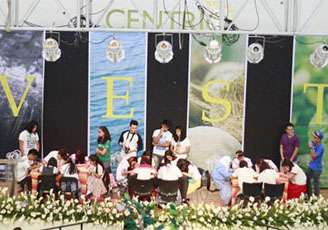By Mary Antonette Magallanes
(This piece won first place during the essay competition – senior category of the Valuing Ecosystem Services Together (VEST) Grand Launch on November 4-7. We are publishing her essay in full. VEST is a region-wide environmental campaign frontlined by Xavier University through the McKeough Marine Center under the Research and Social Outreach cluster; the project has been piloted in Mt Kalatungan, Talakag, Bukidnon.)
Muddy trails and rocky roads touching your soles, winds as cold as ice gushing on your skin, marvellous sceneries delighting your eyes, bountiful plants pleasing your sense of sight and gleeful people greeting you as you pass by—these are only few of the captivating things that one can experience in a far-flung place in Bukidnon, a place home to different wonders, a place called Miarayon.
Miles away from this enthralling vicinity lies a far different locality. Rushing cars and busy people fill the streets from day to night, tall buildings and numerous establishments sprout like mushrooms from left to right—this best describes a place facing the modernization age and globalization, a place embracing the fast-paced changes of the world, a place called Cagayan de Oro City.
Two different places with two different identities and environments; but one thing, one important yet often neglected thing that binds them together and that one thin line that connects the two places is nature, and how it is suffering from environmental degradation.
 Over the years, countless efforts from different people and organizations have emerged addressing the environmental concerns of our city. It is undeniable that the government has done their part and that various NGOs have also given their share in protecting the environment. But, we can see that most (if not all) have actually failed; its most concrete proof? Typhoon Sendong.
Over the years, countless efforts from different people and organizations have emerged addressing the environmental concerns of our city. It is undeniable that the government has done their part and that various NGOs have also given their share in protecting the environment. But, we can see that most (if not all) have actually failed; its most concrete proof? Typhoon Sendong.
Let’s face it, Sendong happened because of the people’s lack of awareness and excessive exploitation of the environment. But the bigger issue is not just the exploitation of the environment here in CDO but as well as the degradation of a wider scope that eventually affected the city.
Throughout the tedious cycle of trying and failing to protect Mother Nature and lessen calamity damages, perhaps now is the time to reassess—what seems to be the actual problem? Well, as the happenings validate it, perhaps the real problem is how environmental efforts sprouted one by one, instead of being AS ONE.
In a more persistent attempt to finally and actually preserve the wonders and importance of the environment, comes the birth of Valuing Ecosystem Services Together (VEST) campaign. VEST is a project yearning to advocate and apply sustainable solution and cooperation through the help of various sectors in the city. Unique from other environmental projects, VEST encourages institutions, organizations, households, professionals, students, basically everyone in the community to engage and take part in the preservation and rehabilitation process. Moreover, VEST also brings in the will and efforts of the people from the highlands to contribute in the helping sustain the life of Mother Nature.
I once heard in a movie, “You cannot change the world alone,” thus, cooperation and collaboration are two of the most vital things we have to consider. In the VEST Project, people from the highlands are also given incentives in return of guarding the forests of Bukidnon, namely Mt Kalatungan and Mt Kitanglad. Preserving the forests would imply that if more trees are planted and grown, less water will trickle down to the lowlands and thus less damage will be incurred during periods of heavy rain can be expected. With this, valuing ecosystem services together, hand in hand with a bigger community ensures a more stable and attainable solution to environmental problems. Not only that, it also results to sustainable cooperation and connection between communities in the highlands and those in lowland urban localities.
VEST now becomes the bigger umbrella of environmental projects and becomes an avenue for small yet significant efforts from the community to actually matter.
On the other hand, for typical students, matters like these only exist in science books and lectures and are – let’s admit it – far from actually being applied in our everyday lives. Phrases such as “preserve Mother Nature” or “Let’s guard the environment” are only clichés often heard by students in compulsory essays and reflection papers. But now, with the existence of VEST, simple efforts of the youth (such as donating money as a barkada or volunteering for the project) can actually make a difference in preserving the environment.
In fact, with VEST, the youth may be encouraged and inspired to help and once again be ignited with the spark of volunteerism and heroism.
With VEST right before our very eyes, there is now a long term solution to the undying problem in our society—in fact, in the whole world, actually. In preserving and nourishing the environment in a wider scope and with a greater, stronger human power backing it up, a more sustainable synergy in the community is now at hand.
Mary Antonette Magallanes is a Development Communication major in Development Journalism student at Xavier University. She received a cash prize worth Php5, 000 and a certificate of recognition from VEST. (Photos by the VEST team)